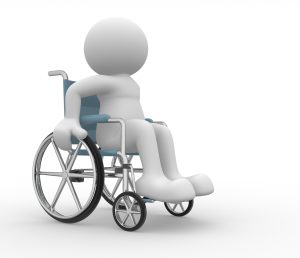The person with physical impairments or decreased sensation
is at increased risk of developing pressure ulcers. The development of these ulcers can be due to pressure, friction, and shearing forces. Shearing refers to movement of body tissues which causes damage to these tissues and potential interruption of blood flow. The risk can be reduced by various strategies e.g. by the use of appropriate seating support to prevent the person sliding down a chair and by using appropriate equipment. Physical impairments which can contribute to the development of pressure ulcers include:
- Maintenance of fixed positions and
 immobility due to physical impairments related to brain injury such as spasticity, hypotonus, dystonia etc. The person may be unable to independently change their body position, relieve areas under pressure and may be subject to prolonged periods of inactivity.
immobility due to physical impairments related to brain injury such as spasticity, hypotonus, dystonia etc. The person may be unable to independently change their body position, relieve areas under pressure and may be subject to prolonged periods of inactivity. - Reduced or absent sensation
which can cause reduced ability to detect pain/discomfort and/or the position in which the affected limb or body part is held. Therefore the person will not then detect signals from their body which would normally promote movement and a change of position. - If the person is in a minimally conscious state they will not be able to change position and relieve areas of pressure.
- Repeated involuntary movements arising from neurological impairments.
- Perseverative movements.
Other Factors Contributing to Reduced Mobility
The person with Acquired Brain Injury may not change their physical position often enough often enough to reduce the risk of pressure ulcers developing. This may occur even in the absence of any physical impairments. For example:
- Cognitive (e.g. apathy, confusion) and communicative impairments may result in the person not being aware of the need to move or being unable to communicate the need to move.
- Depressed mood may cause reduced motivation which may impact on the person’s willingness to move e.g. they may be reluctant to leave their bed or cooperate with repositioning.
- Anxiety and agitation can cause skin to break down in the areas that are subject to repeated friction or pressure as a result of agitated movements. These difficulties may also affect the person’s willingness to cooperate with repositioning.